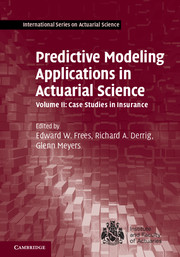Book contents
- Frontmatter
- Contents
- Contributors
- Preface
- Acknowledgments
- 1 Pure Premium Modeling Using Generalized Linear Models
- 2 Applying Generalized Linear Models to Insurance Data: Frequency/Severity versus Pure Premium Modeling
- 3 Generalized Linear Models as Predictive Claim Models
- 4 Frameworks for General Insurance Ratemaking: Beyond the Generalized Linear Model
- 5 Using Multilevel Modeling for Group Health Insurance Ratemaking: A Case Study from the Egyptian Market
- 6 Clustering in General Insurance Pricing
- 7 Application of Two Unsupervised Learning Techniques to Questionable Claims: PRIDIT and Random Forest
- 8 The Predictive Distribution of Loss Reserve Estimates over a Finite Time Horizon
- 9 Finite Mixture Model and Workers’ Compensation Large-Loss Regression Mixture Model and Workers’ Compensation Large-Loss Regression Analysis
- 10 A Framework for Managing Claim Escalation Using Predictive Modeling
- 11 Predictive Modeling for Usage-Based Auto Insurance
- Index
- References
4 - Frameworks for General Insurance Ratemaking: Beyond the Generalized Linear Model
Published online by Cambridge University Press: 05 August 2016
- Frontmatter
- Contents
- Contributors
- Preface
- Acknowledgments
- 1 Pure Premium Modeling Using Generalized Linear Models
- 2 Applying Generalized Linear Models to Insurance Data: Frequency/Severity versus Pure Premium Modeling
- 3 Generalized Linear Models as Predictive Claim Models
- 4 Frameworks for General Insurance Ratemaking: Beyond the Generalized Linear Model
- 5 Using Multilevel Modeling for Group Health Insurance Ratemaking: A Case Study from the Egyptian Market
- 6 Clustering in General Insurance Pricing
- 7 Application of Two Unsupervised Learning Techniques to Questionable Claims: PRIDIT and Random Forest
- 8 The Predictive Distribution of Loss Reserve Estimates over a Finite Time Horizon
- 9 Finite Mixture Model and Workers’ Compensation Large-Loss Regression Mixture Model and Workers’ Compensation Large-Loss Regression Analysis
- 10 A Framework for Managing Claim Escalation Using Predictive Modeling
- 11 Predictive Modeling for Usage-Based Auto Insurance
- Index
- References
Summary
Chapter Preview. This chapter illustrates the applications of various predictive modeling strategies for determining pure premiums in property-casualty insurance. Consistent with standard predictive modeling practice, we focus on methodologies capable of harnessing risk-level information in the ratemaking process. The use of such micro-level data yields statistical models capable of making finer-grained distinctions between risks, thereby enabling more accurate predictions. This chapter will compare multiple analytical approaches for determining risk-level pure premium. A database of personal automobile risks will be used to illustrate the various approaches. A distinctive feature of our approach is the comparison of two broad classes of modeling frameworks: univariate and multivariate. The univariate approach, most commonly used in industry, specifies a separate model for each outcome variable. The multivariate approach specifies a single model for a vector of outcome variables. Comparing the performance of different models reveals that there is no unique solution, and each approach has its own strengths and weaknesses.
Introduction
Ratemaking, the estimation of policy- or risk-level pure premium for the purpose of pricing insurance contracts, is one of the classical problems of general insurance (aka “nonlife,” aka “property-casualty”) actuarial science. For most of the 20th century, ratemaking practice was largely restricted to the one-way analyses of various rating dimensions (such as risk class, prior claims, geographical territory, and so on) with pure premium. Insurers would occasionally employ Bailey-Simonminimum bias methods to account for dependencies amongst rating dimensions. However, the multivariate approach to ratemaking was typically more honored in the breach than the observance due to the information technology limitations of the time and the difficulty of running the iterative Bailey-Simon computational routines. Neither the one-way nor the Bailey-Simon approach was founded in mainstream statistical modeling concepts.
This state of affairs began to change rapidly starting in the mid-1990s thanks partly to increasing availability of computing technology, and partly to the recognition that generalized linear models (GLM) offers practitioners a rigorous, mainstream statistical framework within which Bailey-Simon type calculations, and much else, can be performed (see, e.g., Mildenhall, 1999). GLM methodology offers the ability to move beyond fairly rudimentary analyses of low-dimensional aggregated data to the creation of sophisticated statistical models, containing numerous predictive variables, that estimate expected pure premium at the risk rather than class level.
- Type
- Chapter
- Information
- Predictive Modeling Applications in Actuarial Science , pp. 100 - 125Publisher: Cambridge University PressPrint publication year: 2016
References
- 4
- Cited by

